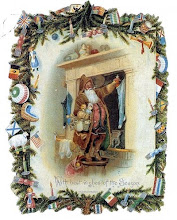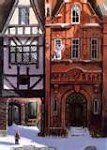Old Fashioned Victorian Era Dickens Style Christmas Traditions
Roasted chestnuts, Christmas punch, figgy pudding, holly and ivy. An old fashioned Victorian Dickens-style Christmas calls for rich family traditions, decorating and fun from bygone days.
Dickens' Christmas: A Victorian Celebration
Background of Victorian Christmas Traditions
Simply Fancy
The Victorian Era refers to the 1837 to 1901 rule of Britain's Queen Victoria. The works of Dickens fall within this time period and are rich in the Christmas traditions of the times.
Generally thought of as a prosperous time because of the effects of the Industrial Revolution, there were still the very rich and very poor, both reflected in Dickens' fiction. But one thing is certain, rich and poor were ready to celebrate the season to the best of their ability.
Elaborate preparations were made with simple materials. Halls were decked with local greenery of every kind. Fruits, nuts and homemade paper decorations adorned Christmas trees. Gifts were often homemade, because of humble circumstances, or because giving of oneself and ones talents was highly valued and most meaningful.
Victorian Christmas Recipes
Right Out of Dickens' Christmas Carol
An old fashioned English Victorian Christmas usually meant roast beef of some kind, but humbler households had wild game or fowl. Chestnuts were roasted in the shell until they popped open. Several potato and vegetable dishes were prepared. Cakes, puddings and pies abounded.
Figgy Pudding
1 cup suet
1 cup sugar
3 large egg yolks
1 cup milk
2 tablespoons rum
1 apple peeled, cored and finely chopped
1 pound dried figs, ground or finely chopped
Grated peel of 1 lemon and 1 orange
1 cup chopped nuts
1/2 teaspoon ground cinnamon
1/4 teaspoon ground cloves
1/4 teaspoon ground ginger
1 1/2 cups dried bread crumbs
2 teaspoons baking powder
3 large egg whites, stiffly beaten
Grease a two-quart mold.
Cream together butter and shortening. Gradually add sugar, egg yolks, milk, extract, apple, figs, lemon and orange peel. Add next 6 ingredients, mixing well. Fold stiffly beaten egg whites into mixture.
Pour into two-quart buttered bowl or mold and place into large shallow pan and steam for four hours.
Custard Sauce
2 cups milk
1 large egg
3/4 cups sugar
1 tablespoon water
1 teaspoon vanilla extract
1 tablespoon flour
1 tablespoon butter
In saucepan, scald milk and allow to cool.
Mix together remaining ingredients, except for butter. Add to cooled milk. Cook over low heat until thickened. Remove from heat and stir in butter, mixing well.
Serve pudding warm with custard sauce or sweetened whipped cream.
Christmas Plum Pudding
1/2 pound beef suet
1 cup flour
1/2 pound raisins (stoned)
1/2 pound currants
2 ounces citron, cut fine
1 cup sugar
Grated rind of 1 lemon
2 cups flour
2 level teaspoonful baking powder
1/4 teaspoonful each, ground cloves and cinnamon
1/2 teaspoonful each mace and salt
2 eggs
1/2 cup sweet milk
Sift together three times the flour, baking powder, spices and salt. Chop fine the suet, mixing it with the cup of flour; add the fruit, sugar, lemon rind, and the flour mixture together. Mix this thoroughly, then stir in the eggs beaten very light and mixed with the milk. The mixture should be quite stiff. Steam six hours in a buttered, two-quart mold. Serve with hard or liquid sauce. Chopped figs or dates and nuts may be used in place of the fruit mentioned.
Rum Sauce
1/2 cup powdered sugar
2 egg yolks
2 egg whites
3 tablespoons rum
1/2 cup beaten cream
Mix sugar, yolks and rum, then the stiffly beaten whites. Cook until thick; add the beaten cream. Chill and serve.
Traditional Yorkshire Pudding
2 cups milk
5 eggs
2 cups flour
1 teaspoon salt
1/2 cup hot beef fat or roast drippings
Preheat the oven to 375°.
Place the milk, eggs, flour, and salt in the blender and blend until smooth. Alternatively, you may use a food processor or mix the ingredients until smooth in a mixer or with a wire whisk.
Pour the drippings into a 9 x 13" shallow glass baking dish or a 12" cast iron pan. Put the pan in the preheated oven for a few minutes to insure that the oil is hot, then remove from the oven and immediately pour the smooth batter into the pan. Return the pan to the oven and bake 30-45 minutes or until puffed and brown.
Serve with roast beef, mashed potatoes, and beef gravy.
Handmade Victorian Christmas Tree Ornaments
Old Fashioned Family Fun Activity
Victorian Christmas trees were mostly decorated with handmade paper ornaments. Pages were cut from magazines and catalogs and pasted or decoupaged and embellished with lace and ribbons. Fans and chains were assembled, and popped corn strung. Pine cones, fruit, nuts and other natural elements also adorned the tree.
What a great way to re purpose leftover fabrics, papers, ribbons, and art supplies. Kids love to create original Christmas decorations.
Victorian Candy Recipes
Sugared Rose Petals, Violets, etc.
Boil 1/2 lb. sugar, 1/2 cup water, and 4 drops lemon juice to the brittle stage. Stir until cool, but still liquid. Then dip rose leaves in this syrup, stirring them well. Take out the leaves and lay on waxed paper to dry. Violets and other edible flowers may also be candied in this manner.
Candied Mint Leaves
Cut a quantity of fresh mint leaves from the stems and clean thoroughly. Then beat the white of an egg until stiff, and brush over each leaf. Then take a cup of granulated sugar, flavored with 15 drops oil of spearmint, and dip the egg-coated mint leaves in the sugar. Place them on waxed paper and dry in a slow oven.
Frosted Gum Drops
4 level Tablespoons unflavored gelatin
1 1/2 cups boiling water
1 cup cold water
4 cups granulated sugar
Food colorings
Flavoring extracts
Soak gelatin in the cold water for five minutes, then stir in the boiling water until perfectly dissolved. Add sugar and boil 25 minutes, counting from time boiling begins, and stirring constantly or it will stick and burn. Turn syrup into four containers. When cool, flavor one with lemon and do not color. Color one with green and flavor with mint or wintergreen. Color one red and flavor with clove or cherry or raspberry. Color one with pink and flavor with rose (or other desired colors and flavors). Pour each in a small pan or candy molds which have been dipped in cold water and let stand overnight in a cold place. Cut in cubes with a knife dipped in boiling water, or unmold. Roll each gum drop in granulated sugar until well coated. Set aside for two days to crystallize.
Lemon Drops
Into one cup of powdered sugar stir just enough strained lemon juice to dissolve the sugar. Cook without stirring to the brittle stage. Drop from spoon tip on sugared (with granulated sugar) platter, sprinkling the tops as well, and set away to cool and harden.
Chocolate Flavored Turkish Delight
3 Level tablespoonfuls of granulated gelatin
1/2 C cold water
2 C sugar
2/3 cup of cold water
1 tsp ground cinnamon
2 squares premium chocolate
1 tsp vanilla extract
1 C French candied fruit, cherries, angelica, citron, etc. chopped fine
Let the gelatin stand in the half cup of cold water until it has taken up all of the water. Stir the sugar and the 2/3 C of cold water over the fire until the sugar is dissolved and the syrup is boiling, then add the gelatin and let cook twenty minutes. Add the cinnamon, the chocolate, melted over hot water, and beat all together. Then add the vanilla and the fruit. Let stand in a cool place for a time, then when it thickens a little turn into an unbuttered bread pan and set aside until the next day. To unmold, separate the paste from the pan at the edge with a sharp pointed knife. Sift confectioner's sugar over the top, then with the tips of the fingers gently pull the paste from the pan to a board dredged with confectioner's sugar. Cut into strips, then into small squares. Roll each square in confectioner's sugar. In cutting keep sugar between the knife and the paste.
Tuesday, December 1, 2009
Background of Victorian Christmas Traditions
Simply Fancy
The Victorian Era refers to the 1837 to 1901 rule of Britain's Queen Victoria. The works of Dickens fall within this time period and are rich in the Christmas traditions of the times.
Generally thought of as a prosperous time because of the effects of the Industrial Revolution, there were still the very rich and very poor, both reflected in Dickens' fiction. But one thing is certain, rich and poor were ready to celebrate the season to the best of their ability.
Elaborate preparations were made with simple materials. Halls were decked with local greenery of every kind. Fruits, nuts and homemade paper decorations adorned Christmas trees. Gifts were often homemade, because of humble circumstances, or because giving of oneself and ones talents was highly valued and most meaningful.
The Victorian Era refers to the 1837 to 1901 rule of Britain's Queen Victoria. The works of Dickens fall within this time period and are rich in the Christmas traditions of the times.
Generally thought of as a prosperous time because of the effects of the Industrial Revolution, there were still the very rich and very poor, both reflected in Dickens' fiction. But one thing is certain, rich and poor were ready to celebrate the season to the best of their ability.
Elaborate preparations were made with simple materials. Halls were decked with local greenery of every kind. Fruits, nuts and homemade paper decorations adorned Christmas trees. Gifts were often homemade, because of humble circumstances, or because giving of oneself and ones talents was highly valued and most meaningful.
Subscribe to:
Posts (Atom)









